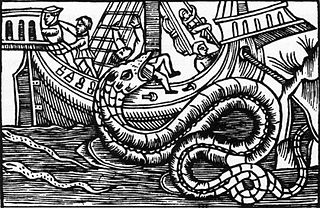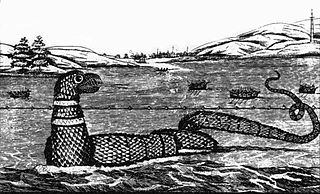
The Loch Ness Monster, affectionately known as Nessie, is a creature in Scottish folklore that is said to inhabit Loch Ness in the Scottish Highlands. It is often described as large, long-necked, and with one or more humps protruding from the water. Popular interest and belief in the creature has varied since it was brought to worldwide attention in 1933. Evidence of its existence is anecdotal with a number of disputed photographs and sonar readings.

A sea serpent or sea dragon is a type of dragon sea monster described in various mythologies, most notably Mesopotamian (Tiamat), Judaeo-Christian (Leviathan), Greek, and Norse (Jörmungandr).

Lake Manitoba is the 14th largest lake in Canada and the 33rd largest lake in the world with a total area of 4,624 km2 (1,785 sq mi). It is located within the Canadian province of Manitoba about 75 km (47 mi) northwest of the province's capital, Winnipeg, at 50°59′N98°48′W.

Sea monsters are beings from folklore believed to dwell in the sea and are often imagined to be of immense size. Marine monsters can take many forms, including sea dragons, sea serpents, or tentacled beasts. They can be slimy and scaly and are often pictured threatening ships or spouting jets of water. The definition of a "monster" is subjective; further, some sea monsters may have been based on scientifically accepted creatures, such as whales and types of giant and colossal squid.
Cadborosaurus, nicknamed Caddy by journalist Archie Wills, is a sea serpent in the folklore of regions of the Pacific Coast of North America. Its name is derived from Cadboro Bay in Greater Victoria, British Columbia, and the Greek root word "saurus" meaning lizard or reptile.

In Canadian folklore, the Ogopogo is a lake monster said to inhabit Okanagan Lake in British Columbia, Canada. Some scholars have charted the entity's development from First Nations folklore and widespread water monster folklore motifs. The Ogopogo now plays a role in the commercial symbolism and media representation of the region.

Storsjön is the fifth largest lake in Sweden, with an area of 464 km2 (179 sq mi) and a greatest depth of 74 m (243 ft). It is the largest lake in central Sweden, located in the province of Jämtland in modern Jämtland County. From Storsjön runs the river Indalsälven and the lake contains the major island Frösön. The city of Östersund is located on the east shore of the lake, opposite Frösön.

In Swedish folklore, the Storsjöodjuret is a lake monster said to live in the 90-metre-deep (300 ft) lake Storsjön in Jämtland in the middle of Sweden.
In northeastern Ohio and Michigan folklore, Bessie is a name given to a lake monster in Lake Erie, also known as South Bay Bessie or simply The Lake Erie Monster. The first recorded sighting of Bessie occurred in 1817, and more sightings have occurred intermittently and in greater frequency in the last three decades. Bessie is reported to be snake-like and 30 to 40 ft long, at least a foot in diameter, with a grayish color.

In Canadian folklore, Memphre is a lake monster said to live in Lake Memphremagog, a fresh water glacial lake located between Newport, Vermont, United States and Magog, Quebec, Canada.

Lake Utopia is located in eastern Charlotte County, New Brunswick.

The Inner and Outer Hebrides off the western coast of Scotland are made up of a great number of large and small islands. These isolated islands are the source of a number of Hebridean myths and legends. The Hebridean Islands are a part of Scotland that have always relied on the surrounding sea to sustain the small communities which have occupied parts of the islands for centuries, resulting in a number of sea legends relating to these local islands.
In Lake Tahoe folklore, Tahoe Tessie is a creature which resides in North America's largest alpine lake, Lake Tahoe, located in Nevada and California. It is said to live in an underwater tunnel that is beneath Cave Rock. Founder of the University of California, Davis's Tahoe Research Group Charles R. Goldman attributes claimed sightings to pareidolia and the mistaken identification of a large breed of fish introduced to Lake Tahoe during trout and mackinaw plantings. The talk of Tessie is similar to the Loch Ness monster "Nessie".
In Idaho folklore, Sharlie is the name given to a sea serpent much like the Loch Ness Monster that is believed by some to live in the deep alpine waters of Payette Lake near McCall, Idaho.

A water horse is a mythical creature, such as the Ceffyl Dŵr, Capaill Uisce, the bäckahäst and kelpie.

In Canadian folklore, the Igopogo is a mythical creature said to dwell in Lake Simcoe, Ontario. The creature's name is ostensibly based on the Ogopogo, of Lake Okanagan, British Columbia, and also the title of the 1952 book I Go Pogo, a slogan often mentioned in the comic. Other nicknames for the Igopogo include Beaverton Bessie, after Beaverton, Ontario, and "Kempenfelt Kelly" after the bay that extends from the lake into the city of Barrie, Ontario. The city of Barrie erected a sculpture of the Igopogo at the waterfront.

In Icelandic folklore, the Lagarfljótsormur or Lagarfljót worm is a lake monster purported to live in Lagarfljót, a lake by the town of Egilsstaðir.
The dingonek is a creature said to have been seen near Lake Victoria in 1907 by big game hunter John Alfred Jordan and members of his hunting party, as recounted by fellow big-game hunter Edgar Beecher Bronson in his 1910 memoir In Closed Territory. This account was followed by an article published in 1913 in the East Africa Natural History Society by Charles William Hobley, in which he claims to have encountered further accounts of similarly described creatures. In 1918, an article published by MacLean's declared that the beast was a newly discovered animal species.

The Gloucester sea serpent is a legendary creature reportedly seen around and off the coast of Gloucester, Massachusetts and Cape Ann area in the United States. The heyday of sightings began in August 1817 and continued into 1818–19. Described as a massive serpent-like creature with humps along its back, the Gloucester Sea Serpent has been the subject of numerous sightings and tales of encounters by fishermen and sailors. The earliest alleged sighting of such a creature off Cape Ann was recorded in 1638 by John Josselyn. Occasional sightings continued over the centuries and into the 20th century.

The Mugwump is a lake monster which has been alleged to live in Lake Timiskaming, on the border of the Canadian provinces of Ontario and Quebec.














